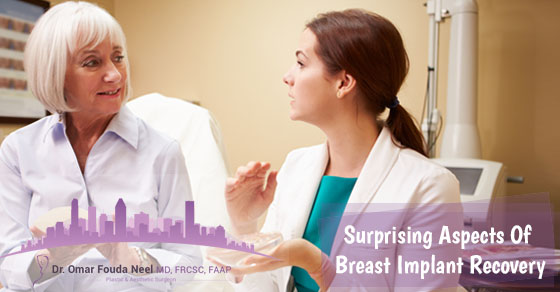6 Things You Didn’t Expect About Breast Implant Recovery
Since you are reading this article, chances are that you have been thinking about undergoing breast augmentation with me in Montreal, and you probably have already done some research about this procedure. However, there are a few things you may not have learned in your research about what can happen during your recovery from a breast implant surgery.

To give you a better understanding of what to expect after your surgery, we’re taking a look at 6 surprising aspects of breast implant recovery.
- The level of post-op pain and discomfort is relative.
- There may be some fluid retention and weight gain.
- It may be difficult to sleep.
- Exercise, but progressively.
- Returning to work – sooner or later?
- “Owning” your new breasts
You may have read that recovery from a breast implant involves pain. As with any surgery, it is normal to experience pain and discomfort afterwards. However, the duration and intensity of pain during breast augmentation recovery varies depending on the individual and the type of surgery done.
Different people heal differently. For instance, some doctors have found that women who have had children may have less pain in the postoperative phase, and they tend to have a much higher pain tolerance. As well, the type of augmentation performed can affect the level of discomfort the patient experiences. Larger implants and subpectoral implant placement tend to cause more pain in the recovery phase.
A subpectoral placement requires surgery on a muscle (a space for the implant needs to be created behind the pectoralis major muscle), and that usually causes more pain. On the other hand, this type of breast augmentation does provide the patient with more coverage over the implants and is thought to lower risk of complications caused by the response of the immune system to foreign objects in the body, known as capsular contracture.
You can expect the first 1-4 days of recovery to have the most discomfort. You may have pains on the outside of your breasts from nerve endings regeneration, and between the breasts where the skin is most stretched. You may also be more sore in the morning, but this lessens in a few days.
Do take your pain medication. Your doctor will prescribe you the appropriate pain medication which will make the recovery much easier. If you’re finding that you’re still experiencing discomfort despite taking medication, try to use deep breathing exercises and other relaxation techniques to ease the pain. Also take this as a red flag that you may be exerting yourself too much: use less movement in your day-to-day life, and minimize the amount of weight you’re lifting.
Fluid retention is common, as is weight gain, during the first three days of recovery, and you also may have bloating for a week or so caused by fluids from the surgery moving downward. Drink lots of water to flush it out. Your belly may be swollen for up to 10 days after the surgery.
Many women experience sleeping problems right after augmentation surgery caused by the weight of the implants and the general discomfort. As you will have to sleep on your back, it’s a good idea to practice sleeping that way before the surgery. You should sleep as much as possible during the recovery period – sleep helps with pain management and the healing process. Sometimes a couch or a recliner is easier to sleep on because it gives back support. Or you can try sleeping on elevated pillows.
During the first two weeks post-surgery the only exercise you can do is light walking. Your doctor may permit you to do some implant displacement exercises within 4-7 days of surgery. After a couple of weeks you can increase your physical activity such as low impact exercises, but you should avoid upper body resistance exercises.
You can gradually increase your workout in the second month, but wait until at least eight weeks go by before you attempt any activities that require upper body exertion (IE push-ups or heavy lifting.) It is also important to make sure that the breasts are well supported during any exercise; a firmly fitting sports bra will be a necessity.
The time to return to work depends on the individual, her healing process, and what kind of a job she does.Some patients go back to work the next day (not really advisable), and some take as much as 2 weeks off from work.
Scar tissues will gradually relax and soften, but it may take up anywhere between 2- 9 months. This is also the period when the stiffness/firmness of the breasts will dissipate as the implants descent and, as the breasts become softer and acquire their natural jiggle, most patients at this stage start to feel that the implants have become a natural part of their body.
For most women, getting implants is something they only do once in their lifetime, so it’s natural to be unaware of what you should expect. If you have any questions about the surgery or recovery process, contact Dr. Fouda Neel’s team today.














